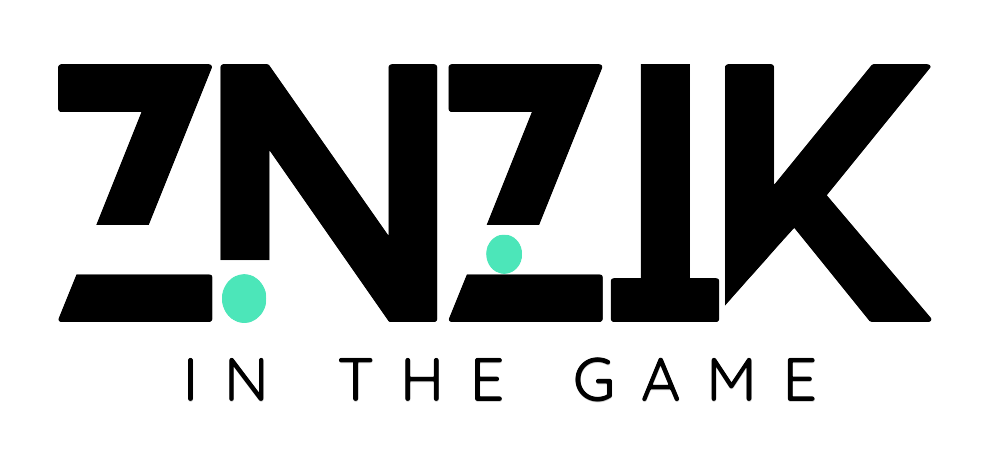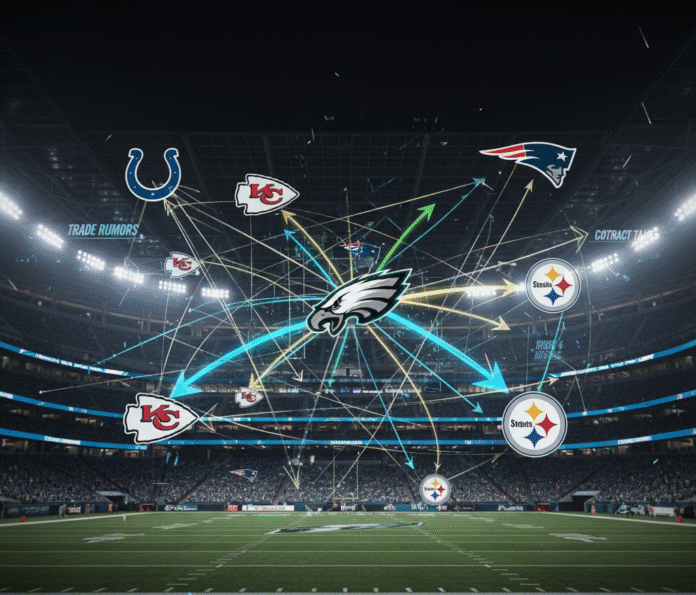A.J. Brown’s reported discontent with the Philadelphia Eagles and his complex contract situation have fueled persistent trade rumors ahead of the 2025 NFL deadline. Despite official denials from GM Howie Roseman, rival teams like the Colts, Patriots, and Steelers are monitoring the situation closely.
Each destination offers a different strategic fit—Indianapolis could reunite Brown with Shane Steichen, New England could accelerate Drake Maye’s development under Mike Vrabel, and Pittsburgh might make an aggressive win-now move. However, Philadelphia’s financial constraints, roster dynamics, and public commitment to Brown make a trade unlikely unless tensions escalate or a franchise offers overwhelming compensation.
A.J. Brown Trade Rumors: Analyzing Potential Destinations (Steelers, Patriots, Colts)
The NFL’s trade deadline creates annual theater where speculation, rumor, and occasional reality converge as teams assess whether their seasons justify buying talent or selling assets for future considerations. Among the 2025 trade deadline’s most intriguing storylines: persistent rumors surrounding Philadelphia Eagles star wide receiver A.J. Brown, whose combination of elite talent, substantial contract, and reported discontent has sparked speculation about whether the Eagles might actually trade one of the league’s premier offensive weapons.
Brown’s situation encapsulates the complex dynamics that generate blockbuster trade possibilities. He’s unquestionably among the NFL’s best receivers—a player who can single-handedly transform offenses through his combination of size, speed, route-running precision, and contested-catch ability. Yet his relationship with quarterback Jalen Hurts has reportedly frayed, his production has fluctuated amid offensive coordinator changes, and the Eagles face difficult roster-building decisions about where to allocate resources. These tensions create the uncertainty that fuels trade speculation even for players teams would normally never consider moving.
The potential destinations analyzed here—Indianapolis Colts, New England Patriots, and Pittsburgh Steelers—represent three distinct strategic approaches to acquiring elite offensive talent. The Colts would reunite Brown with former Eagles offensive coordinator Shane Steichen, now their head coach, providing scheme familiarity and proven chemistry. The Patriots would pair Brown with promising young quarterback Drake Maye while leveraging head coach Mike Vrabel’s rumored connections to potentially facilitate a deal. The Steelers would make an aggressive win-now move aimed at maximizing their championship window.
Understanding whether any of these scenarios might materialize requires examining not just the trade packages proposed but the broader contexts driving trade speculation, the Eagles’ actual willingness to move Brown despite public denials, and whether the compensation frameworks make sense for both acquiring teams and Philadelphia.
Rising Tensions with the Eagles: Context Behind the Trade Rumors
Contract and Initial Acquisition: Philadelphia’s Gamble
The Eagles acquired A.J. Brown via trade with the Tennessee Titans in April 2022, sending first- and third-round picks in the 2022 draft plus a third-rounder in 2023 to Tennessee in exchange for Brown and a seventh-round pick. This aggressive move signaled Philadelphia’s belief that adding elite receiving talent represented the missing piece for their championship aspirations following a disappointing 2021 season.
The acquisition immediately proved transformative. Brown posted 1,496 receiving yards and 11 touchdowns in his first Eagles season, forming what appeared to be a dynamic partnership with second-year quarterback Jalen Hurts. The combination helped propel Philadelphia to a 14-3 record and Super Bowl LVII appearance, validating the trade as exactly the difference-making move that general manager Howie Roseman envisioned.
Philadelphia then compounded their commitment by signing Brown to a massive three-year, $96 million contract extension ($32 million annually) that made him one of the NFL’s highest-paid receivers. This extension—awarded before his first Eagles season even concluded—reflected both Brown’s immediate impact and Philadelphia’s desire to lock up a cornerstone offensive weapon for Hurts’s development window.
The contract structure now complicates any potential trade. Brown’s substantial cap hits make acquiring him expensive for potential trade partners, while the dead money Philadelphia would absorb by trading him creates financial disincentives despite whatever interpersonal or strategic issues might exist. Teams evaluating trades must account for not just the acquisition cost in draft picks and players but also their ability to accommodate Brown’s salary within their cap structures.
The initial acquisition’s success makes current trade speculation particularly striking. Less than three years after mortgaging significant draft capital to acquire Brown and immediately extending him with a massive contract, the Eagles might be considering moving him? This dramatic reversal, if it occurs, would represent a stunning admission that the partnership hasn’t worked as envisioned despite the initial on-field success.
Discord and Uneven Production: Signs of A.J. Brown’s Discontent
Strained Relationship with Jalen Hurts
The reported friction between Brown and Hurts represents the most concerning element of this situation. NFL offenses depend fundamentally on quarterback-receiver chemistry—the timing, trust, and mutual understanding that separate functional passing games from elite ones. When star quarterbacks and receivers don’t connect personally or professionally, offensive production suffers regardless of individual talent levels.
The specific nature of Brown-Hurts tensions remains somewhat murky, with conflicting reports and both parties generally maintaining public professionalism. However, patterns visible in game film and statistical production suggest legitimate on-field issues: targets and receptions fluctuating game-to-game, apparent miscommunications on route concepts, and body language suggesting frustration with coverage attention or quarterback decisions.
These tensions allegedly stem from multiple sources. Brown reportedly believes Hurts doesn’t look his way enough despite defensive attention creating opportunities elsewhere. Hurts, meanwhile, might feel Brown’s route-running occasionally deviates from called concepts or that Brown’s public comments create unnecessary distractions. Whether these represent genuine incompatibility or normal star-player friction that improved communication could resolve remains unclear.
The comparison to Brown’s previous situation in Tennessee adds context. He thrived with Ryan Tannehill despite Tannehill’s limitations, suggesting Brown can succeed with imperfect quarterback play. Yet Tannehill consistently fed Brown targets—often too many, to the point of predictability. Hurts’s more distributed approach and occasional preference for running over throwing might simply not align with Brown’s expectations for involvement regardless of the interpersonal relationship dynamics.
Impact of New Offensive Coordinator
Philadelphia’s 2024 hiring of Kellen Moore as offensive coordinator introduced additional volatility to Brown’s situation. Moore brings a different philosophical approach than former coordinator Shane Steichen (now Colts head coach), whose offense Brown thrived in during his first Eagles season. Moore’s system emphasizes different route concepts, timing patterns, and personnel deployment that require receivers to adapt to new expectations.
This coordinator change could explain some of Brown’s production fluctuations and reported frustrations. Learning new systems takes time even for veterans, and the adjustment period often creates temporary dips in efficiency and comfort level. If Brown feels the new scheme doesn’t utilize his strengths optimally or if he struggles with certain concepts Moore emphasizes, legitimate football reasons might underlie his reported discontent beyond simple personality conflicts.
The coordinator change also affected Hurts, who similarly had to adapt to different play-calling and conceptual frameworks after succeeding in Steichen’s system. The dual adjustment by both quarterback and star receiver, occurring simultaneously without the architect who initially made their partnership succeed, created opportunities for miscommunication and frustration that might not have emerged had continuity been maintained.
The Front Office Dilemma (Howie Roseman)
Reluctance to Trade the Player Despite Potential Team Issues
Eagles general manager Howie Roseman faces extraordinarily difficult calculations about whether trading Brown might actually benefit Philadelphia despite the obvious talent loss. On one hand, moving an elite receiver in his prime seems like organizational malpractice—you don’t accumulate talent by trading away your best players. On the other, if Brown’s presence creates locker room tension, affects Hurts’s development, or represents capital that could be reallocated to address other roster needs, the unconventional move might make strategic sense.
Roseman’s reputation as an aggressive, unconventional executive who isn’t bound by traditional thinking makes Brown trade rumors somewhat plausible despite their surface absurdity. Roseman has repeatedly demonstrated willingness to make counterintuitive moves—trading up aggressively in drafts, moving veterans despite remaining productivity, and reshaping rosters in ways that initially draw criticism but often prove prescient. If he’s concluded that Brown’s situation has become untenable or that the compensation available justifies the talent loss, he might actually pull the trigger despite the public perception risks.
However, Roseman also understands the franchise-defining nature of such a decision. Trading Brown would generate enormous criticism and second-guessing, particularly if Brown thrives elsewhere while Philadelphia’s offense struggles. The move would also send concerning messages about the organization’s stability and commitment to championship building. These reputational and strategic considerations might outweigh whatever football logic might support a trade.
The timing also complicates the decision. Trading Brown now, with multiple years remaining on his contract, differs fundamentally from moving players in contract years where you might lose them in free agency regardless. Brown’s under contract through 2027—Philadelphia controls his rights for multiple seasons and doesn’t face the “trade him now or lose him for nothing” pressure that drives many deadline deals. This control gives Roseman time to attempt resolving issues internally rather than making hasty trade decisions driven by short-term dysfunction.
Three Bold Trade Ideas: Compensation Projects for Philadelphia
Scenario 1: Indianapolis Colts
Justification: Serious Playoff Hope and Connection with Coach Shane Steichen
The Colts represent perhaps the most natural landing spot given Shane Steichen’s presence as head coach. Steichen coordinated Philadelphia’s offense during Brown’s dominant first season with the Eagles, meaning he intimately understands how to maximize Brown’s talents within offensive schemes. This scheme familiarity eliminates the learning curve that would exist with entirely new systems, allowing Brown to contribute immediately at peak efficiency.
The reunion also offers psychological benefits beyond scheme fit. If Brown’s Eagles frustrations stem partly from the post-Steichen offensive changes, returning to a coach he succeeded with could restore his engagement and eliminate whatever dysfunction exists in Philadelphia. Steichen, likewise, would gain a proven offensive weapon he’s already built successful game plans around, reducing the uncertainty inherent in incorporating new players mid-season.
Indianapolis’s competitive position also justifies aggressive moves. If the Colts genuinely believe they’re playoff contenders—a plausible assessment depending on their record at the deadline and the AFC’s competitive landscape—adding elite receiving talent could provide the offensive firepower necessary for postseason success. Young quarterbacks Anthony Richardson or veteran alternatives would benefit enormously from Brown’s playmaking ability, potentially accelerating whatever quarterback development or veteran production the Colts are relying upon.
Compensation: WR Alec Pierce, OLB Kwity Paye, 3rd Round Pick (2026)
This proposed package attempts balancing Philadelphia’s need for immediate roster help with future assets:
WR Alec Pierce provides Philadelphia a young replacement receiver who, while not approaching Brown’s elite tier, offers developmental upside and immediate roster depth. Pierce’s cost-controlled contract (likely still on rookie deal) also addresses the cap space that Brown’s departure would create, allowing Philadelphia to reallocate resources rather than simply cutting salary. However, Pierce as the primary “return piece” for an elite receiver represents substantial value concession—he’s a decent young player but nowhere near Brown’s impact level.
OLB Kwity Paye addresses Philadelphia’s edge rusher needs, providing a young, athletic pass rusher on a rookie contract. If the Eagles believe their defensive line needs reinforcement or that Paye’s upside exceeds his current production, he represents valuable return. However, he’s also a player Indianapolis has invested in developing and presumably values highly, making his inclusion questionable from the Colts’ perspective unless they view him as expendable.
The third-round pick adds future draft capital but represents relatively modest value for a player of Brown’s caliber. Third-rounders certainly can develop into quality starters, but statistically, most don’t reach star levels. Using a third-rounder as the pick component (rather than first or second) suggests either limited Eagles leverage in negotiations or recognition that Brown’s contract and reported issues depress his trade value below what elite receivers typically command.
Evaluation: This package likely undervalues Brown from Philadelphia’s perspective unless they’re truly desperate to move him. Two young players with promise but uncertain ceilings plus a mid-round pick doesn’t obviously match the value of a proven elite receiver in his prime. However, if internal dysfunction has truly cratered Brown’s value to Philadelphia—making him essentially addition by subtraction—then acquiring useful players and a pick might represent the best available return.
From Indianapolis’s perspective, the package seems expensive but potentially justifiable for a proven game-changer. Giving up two developing players and a pick for someone who immediately makes them more dangerous offensively could tip playoff odds enough to warrant the sacrifice if they’re genuinely contending.
Scenario 2: New England Patriots
Justification: Desire to Strengthen Offensive Arsenal for Drake Maye and Connection with Mike Vrabel
The Patriots’ interest would center on accelerating young quarterback Drake Maye’s development by surrounding him with elite talent rather than forcing him to develop with subpar supporting cast. Maye, presumably New England’s quarterback of the future, would benefit enormously from a security blanket like Brown—a receiver who wins consistently, makes contested catches, and demands defensive attention that creates opportunities for others.
The Mike Vrabel connection referenced suggests his presence as head coach might facilitate trade discussions through personal relationships with Eagles decision-makers or his ability to sell Brown on New England’s project. Vrabel’s respected status across the league and potential connections to Brown through their brief overlapping time in the AFC South (Vrabel coached Tennessee while Brown played there) could smooth negotiations or help convince Brown that New England represents an attractive destination despite the franchise’s recent struggles.
However, the strategic logic of New England—currently in rebuilding mode with uncertain playoff prospects this season—making an aggressive win-now trade seems questionable. Teams in the Patriots’ situation typically focus on accumulating young talent and draft capital rather than trading for expensive veterans. Unless Vrabel genuinely believes the team is closer to contention than their record suggests, or unless ownership has mandated accelerating the rebuild regardless of conventional timelines, the Patriots seem unlikely trade partners for immediate impact veterans.
Compensation: WR Kayshon Boutte, OLB K’Lavon Chaisson, 3rd Round Pick (2026)
This package mirrors the Colts proposal’s structure while substituting Patriots-specific players:
WR Kayshon Boutte represents a young receiver with draft pedigree (sixth-round pick in 2023) who hasn’t yet developed into impact player. Like Pierce in the Colts scenario, Boutte provides Philadelphia a young replacement with upside but not someone remotely approaching Brown’s current impact. His inclusion suggests the Patriots lack more valuable young receivers to offer or that Philadelphia values Boutte’s specific skill set.
OLB K’Lavon Chaisson brings pass rush experience having been a first-round pick (2020) whose career hasn’t met expectations. If Philadelphia believes their coaching staff can unlock Chaisson’s potential or if they simply need edge depth, he provides some value. However, he’s also largely viewed as a disappointing draft pick whose trade value probably sits well below what his initial draft position would suggest. Including him might be more about New England shedding a bust than Philadelphia receiving meaningful value.
The third-round pick again provides modest future draft capital without representing premium return for elite talent.
Evaluation: This Patriots package seems even weaker than the Colts proposal given that both Boutte and Chaisson represent players who haven’t established themselves as quality NFL contributors. Trading an elite receiver for two developmental players and a mid-round pick would represent desperation trading unless Philadelphia views both players as having significant upside their evaluation processes make them confident in unlocking.
From New England’s perspective, the package seems reasonable if they’re not mortgaging first-round picks or established contributors. They’re essentially offering two former draft picks who haven’t worked out plus a future mid-rounder for a legitimate star—that’s a trade they’d make instantly if Philadelphia accepted. Whether the Patriots would actually include more valuable assets if pressed—perhaps a second-round pick instead of third, or a different player with higher trade value—remains the negotiation question.
Scenario 3: Pittsburgh Steelers
Justification: Aggressive Strategy to Maximize Winning Opportunity with Aaron Rodgers
Wait—this scenario mentions Aaron Rodgers with the Steelers? That seems like an error in the original outline, as Rodgers plays for the New York Jets. Perhaps this should reference the Steelers maximizing their window with their current quarterback situation (likely Russell Wilson or whoever their starter is in 2025), or perhaps there’s confusion with the Jets as a potential destination. I’ll proceed assuming this means the Steelers making an aggressive move to maximize their current competitive window with their veteran quarterback situation, whoever that may be.
The Steelers’ interest would reflect their organizational philosophy of sustained competitiveness and their belief that adding elite offensive talent could push them into genuine championship contention. Pittsburgh traditionally competes for playoffs but often lacks the elite offensive weapons that put teams over the top. Adding Brown would immediately upgrade their receiving corps, potentially transforming a good offense into a great one.
The “aggressive strategy” framing suggests the Steelers recognize their championship window might be closing—whether due to defensive players aging, quarterback situations, or other roster factors—and are willing to mortgage some future to maximize present chances. This win-now mentality would justify paying premium prices for proven talent rather than continuing to build through draft and develop.
Compensation: TE Pat Freiermuth, OLB Alex Highsmith, 3rd Round Pick (2026), (Potential Exchange of Azeez Ojulari)
This package represents the most substantial of the three proposals, including two established NFL starters:
TE Pat Freiermuth provides Philadelphia a young, productive tight end on a rookie contract. If the Eagles value tight end position or believe Freiermuth’s skill set fits their offensive plans, he represents genuine value—a player who’s already proven NFL productivity rather than mere developmental prospect. However, trading Freiermuth would leave Pittsburgh thin at tight end unless they have developmental players ready to assume starting roles.
OLB Alex Highsmith would be massive get for Philadelphia—an established edge rusher who’s become one of Pittsburgh’s best defensive players. Highsmith’s production and contract status (depending on where he is in his deal) make him valuable trade chip. His inclusion suggests Pittsburgh is truly going all-in on the Brown acquisition, willing to sacrifice defensive talent to acquire offensive firepower. However, it also makes the trade questionable from Pittsburgh’s perspective—why weaken your defense substantially to strengthen your offense unless you’re absolutely certain the offensive improvement outweighs defensive regression?
The third-round pick again provides modest draft capital.
The mention of “potential exchange of Azeez Ojulari” adds confusion since Ojulari plays for the New York Giants, not any team involved in this trade scenario. This might be an error in the source material or might reference a three-team trade structure where players from non-primary teams get involved. Without clearer context, it’s difficult to evaluate this component.
Evaluation: This Steelers package seems most substantial of the three proposals given that both Freiermuth and Highsmith are proven NFL contributors rather than developmental players. If Philadelphia is truly willing to trade Brown, this type of return—two young starters plus a pick—might approach fair value depending on contracts and team needs.
From Pittsburgh’s perspective, the package represents enormous bet on Brown’s impact. Giving up starting tight end and edge rusher plus a pick creates meaningful roster holes while adding elite receiving talent. Whether this trade makes them better overall or merely reallocates value from defense to offense without net improvement remains the central evaluation question.
Trade Deadline Updates: Will the Eagles Actually Trade A.J. Brown?
Eagles’ Official Position: Refusal to Negotiate
According to Dianna Russini, Philadelphia Closing Door to Calling Teams
Dianna Russini, a respected NFL insider, reporting that Philadelphia is rebuffing trade inquiries about Brown provides the most concrete information about the Eagles’ actual intentions versus mere speculation. Teams inquiring about availability and being told “no” suggests Philadelphia isn’t actively shopping Brown despite whatever internal issues might exist.
This refusal could reflect several motivations:
Genuine Commitment to Brown: Perhaps the reports of dysfunction are overblown or represent temporary issues the Eagles believe they can resolve internally. If Philadelphia still views Brown as cornerstone talent central to their championship aspirations, they’d obviously refuse trade overtures regardless of inquiring teams’ offers.
Negotiating Posture: Teams sometimes publicly deny trade availability while privately remaining open to discussions if the compensation is overwhelming. By projecting that Brown is untouchable, Philadelphia might be attempting to drive up potential offers, calculating that interested teams will only present their best proposals if they believe anything less would be instantly rejected.
Avoiding Distraction: Publicly entertaining Brown trade talks would create enormous media circus and locker room distraction during crucial season stretch. The Eagles might be shutting down discussions publicly to maintain focus while privately remaining open to unlikely but theoretically possible scenarios if someone presented godfather offer too valuable to refuse.
Strategic Misdirection: In NFL front office maneuvering, misdirection is common. Teams leak information suggesting they’re not trading players right up until announcing deals. The public refusal might be meaningless if serious discussions are happening through backchannel communications that reporters aren’t privy to.

The fact that teams are calling at all confirms that the rumors have substance—NFL general managers don’t waste time on purely speculative calls. Something about Brown’s situation has created perception of availability, whether through his agent floating the possibility, league-wide rumors about Eagles dysfunction, or other sources suggesting Brown might be attainable despite public denials.
Follow-Up: Why Patriots (and Vrabel) Keep an Eye on the Situation
Obvious Dysfunction and Brown’s Discontent Making Situation Volatile
The Patriots’ continued monitoring of Brown’s situation despite Philadelphia’s denials reflects their assessment that “no” might not remain “no” if circumstances change. NFL executives understand that public positions shift when situations deteriorate or when compensation packages exceed initial resistance thresholds.
The “obvious dysfunction” reference suggests that whatever is happening between Brown and the Eagles organization has become visible enough that rival teams believe eventual trade becomes plausible despite current denials. This could stem from on-field body language, social media activity, media reports about locker room tension, or other signals indicating genuine problems rather than typical star-player drama.
Mike Vrabel’s involvement (as Patriots head coach, presumably) adds potential facilitation pathway. If Vrabel has relationships with Philadelphia decision-makers or with Brown personally from their AFC South overlap, he might be uniquely positioned to broker discussions if Brown’s situation deteriorates to the point where Philadelphia reconsiners. Vrabel’s reputation and connections could provide credibility to New England’s interest that other suitors might lack.
The “volatile” characterization captures the unpredictable nature of situations involving star players and organizational dysfunction. What seems impossible today—trading an elite receiver under contract for multiple years—might become necessary tomorrow if relationships deteriorate further, if public incidents force organizational action, or if trade deadline timing creates pressure for resolution one way or another.
The A.J. Brown trade rumors represent a fascinating collision of elite talent, organizational dysfunction, complex contract economics, and the NFL’s perpetual trade deadline speculation machine. While Philadelphia’s public denials suggest Brown isn’t actually available, the persistent rumors, reported interpersonal tensions, and rival teams’ continued monitoring indicate genuine uncertainty about whether the situation might reach the breaking point where the unthinkable becomes necessary.
The three proposed trade scenarios—Colts, Patriots, Steelers—illustrate the challenges inherent in trading elite players under contract. The packages proposed would likely require Philadelphia accepting less-than-equal value in tangible talent return, justified only if they conclude that Brown’s presence has become counterproductive despite his on-field contributions. For acquiring teams, the packages represent expensive bets that Brown’s talent will prove worth the sacrificed assets and absorbed contract.
The most likely outcome remains Brown staying in Philadelphia—teams rarely trade elite players in their primes without overwhelming justification. But the mere plausibility of such scenarios reflects the unusual circumstances surrounding Brown’s situation and the NFL’s capacity to generate unexpected blockbuster trades when organizational dysfunctions reach critical mass. Whether this situation explodes into actual trade or fizzles into resolved internal matter will likely be determined in the days leading to the trade deadline, when competitive pressures and organizational assessments crystallize into definitive actions rather than speculative possibilities.Réessayer
Russini: Patriots sources think Belichick is ‘fighting a ghost’ in New England
No-go on A.J. Brown? Dianna Russini shares Patriots trade deadline intel



